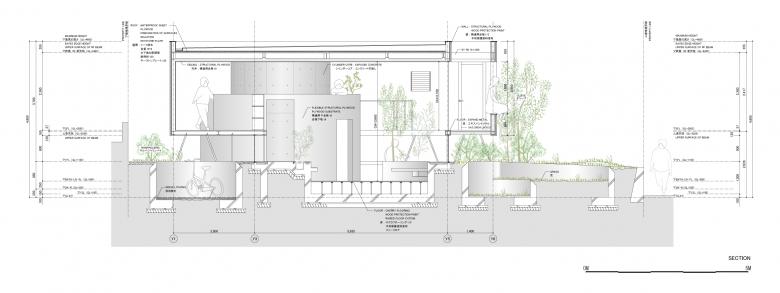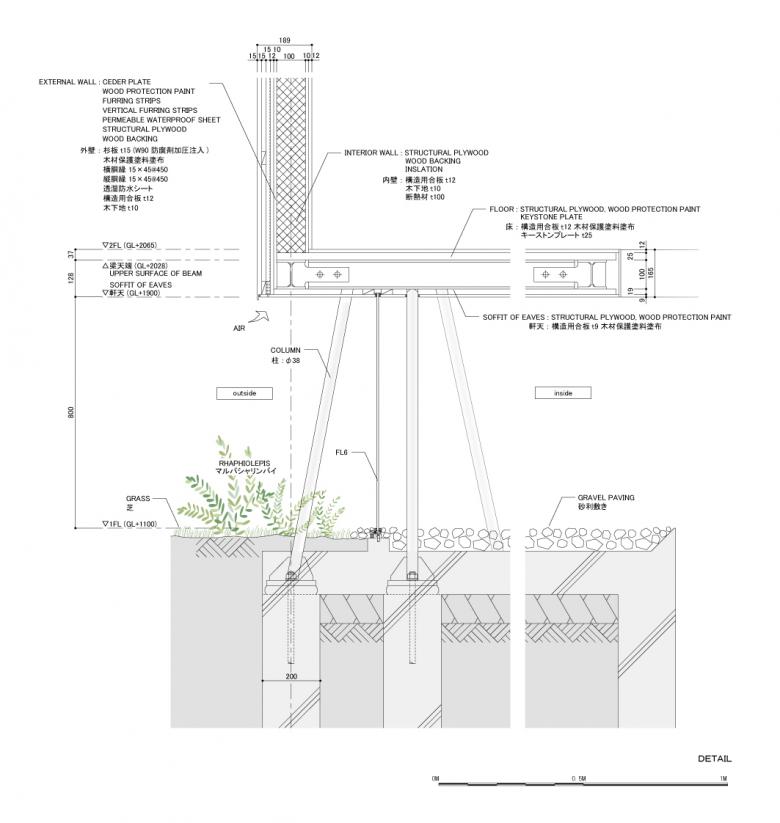PIT HOUSE
PIT HOUSE
1. October 2012
By digging into the terraced building site, architect Keisuke Maeda of UID created a living area that is protected from the elements yet strongly connected to the land. His “House on the Surface of the Earth” is not a pre-conceived structure simply set on the ground, but rather a design guided towards its inevitable end point by the client’s requests and the context of the site. Below, Maeda talks about the project.
North facade. The building is set into a terraced hillside.
Tell us about the basic concept for the project.
The relationship between the natural environment of the site and the structure built on it is defined by the fact that both exist simultaneously. Rather than connecting the two simply by opening a window in a wall, I thought about how to create a structure that exists as one landscape element within the indivisible whole of the environment.
The design allows the residents to take in a 360-degree view of the elevated property, the walls and fences of the neighboring houses that encircle it, the other residences spread out along the hillside, and the distant mountains, all as they go about their daily activities. The interior functions as an extension of the outside, not as a space cut off from the land by walls. My guiding architectural concept was of a dugout-like dwelling linked indivisibly to the earth.
About 50 delicate branch-like poles both suspend the upper box and connect it to the ground.
How did you end up taking on the commission?
The client contacted us after seeing houses we’d designed in magazines and online.
Exterior and interior are linked through the gap below the floating upper story, resulting in an ambiguous space.
Was the house that was actually built different in any way from your design? How did you resolve any problems that arose during the process?
In order to play up the ambiguous sense of distance created by a round shape, which tends to eliminate the feeling of being closed in, we reduced the actual size of the home to the bare minimum. To keep costs down and make the best use of the space, we left the one-meter-high underground foundation supports exposed and incorporated them as an element of the interior. Making these small circular slabs required special precisely-constructed concrete formwork, which we developed through consultation with the building contractor. We also worked with a plywood factory to develop an experimental curved 6mm structural plywood that we used as a finishing material in the central section of the house. Our back-and-forth with the contractor and factory allowed us to acheive a high level of precision and expression that in turn was the key to creating a sense of continuity between the exterior and interior spaces.
Terrace leading to the entrance.
How is this project different from or similar to your past work?
As in the past, our careful investigation of the site characteristics resulted in a natural relationship between the building and the site environment.
Light from the skylight falls through the cylindrical core to the wash room below.
What’s most important to you when you are designing a structure?
I value my intuition. Architecture is about creating an environment in a certain place, and that’s not something you can do just by drawing up a blueprint. The blueprint serves as my basic guide, but I also stay aware of the unique characteristics of the place and value the intuitive decisions I make as I work, because those decisions are what ultimately lead to the creation of a comfortable environment. What I mean by “intuitive decisions,” for instance, are the on-site adjustments to shape and dimensions that I might make to a nursery school approach as I imagine the various scenes that will take place there: the children and teachers and pregnant women who will use it, the people pushing baby carriages or carrying children, the parents walking along holding hands with their child, the caretakers coming to pick up and drop off kids. What I’m aiming for is not to maximize the convenience and functionality of the space, but rather to create an environment that fills people with a sense of wellbeing and comfort in the casual, everyday moments of their life.
Dining area viewed from the bedroom.
Diagram
Floor plan
Section
Detail drawing
Email Interview by Yuna Yagi
Pit House
2011
Okayama
Architect
Keisuke Maeda / UID
Hiroshima
Design Principal
Keisuke Maeda
Structural Engineer
Konishi Structural Engineers
Contractor
Nakamura Construction Company
Landscape Architects
Ogino Toshiya Landscape Architecture
Site Area
232.12㎡
Building Area
115.32㎡
Photos
Hiroshi Ueda
Related articles
-
Spotlight on Italy
on 5/16/18
-
Bologna Shoah Memorial
on 7/20/15









